Related Research Articles

Hypertext Transfer Protocol Secure (HTTPS) is an extension of the Hypertext Transfer Protocol (HTTP). It uses encryption for secure communication over a computer network, and is widely used on the Internet. In HTTPS, the communication protocol is encrypted using Transport Layer Security (TLS) or, formerly, Secure Sockets Layer (SSL). The protocol is therefore also referred to as HTTP over TLS, or HTTP over SSL.
Trusted Computing (TC) is a technology developed and promoted by the Trusted Computing Group. The term is taken from the field of trusted systems and has a specialized meaning that is distinct from the field of confidential computing. With Trusted Computing, the computer will consistently behave in expected ways, and those behaviors will be enforced by computer hardware and software. Enforcing this behavior is achieved by loading the hardware with a unique encryption key that is inaccessible to the rest of the system and the owner.
X.500 is a series of computer networking standards covering electronic directory services. The X.500 series was developed by the Telecommunication Standardization Sector of the International Telecommunication Union (ITU-T). ITU-T was formerly known as the Consultative Committee for International Telephony and Telegraphy (CCITT). X.500 was first approved in 1988. The directory services were developed to support requirements of X.400 electronic mail exchange and name lookup. The International Organization for Standardization (ISO) and International Electrotechnical Commission (IEC) were partners in developing the standards, incorporating them into the Open Systems Interconnection suite of protocols. ISO/IEC 9594 is the corresponding ISO/IEC identification.

A public key infrastructure (PKI) is a set of roles, policies, hardware, software and procedures needed to create, manage, distribute, use, store and revoke digital certificates and manage public-key encryption. The purpose of a PKI is to facilitate the secure electronic transfer of information for a range of network activities such as e-commerce, internet banking and confidential email. It is required for activities where simple passwords are an inadequate authentication method and more rigorous proof is required to confirm the identity of the parties involved in the communication and to validate the information being transferred.
In cryptography, a public key certificate, also known as a digital certificate or identity certificate, is an electronic document used to prove the validity of a public key. The certificate includes the public key and information about it, information about the identity of its owner, and the digital signature of an entity that has verified the certificate's contents. If the device examining the certificate trusts the issuer and finds the signature to be a valid signature of that issuer, then it can use the included public key to communicate securely with the certificate's subject. In email encryption, code signing, and e-signature systems, a certificate's subject is typically a person or organization. However, in Transport Layer Security (TLS) a certificate's subject is typically a computer or other device, though TLS certificates may identify organizations or individuals in addition to their core role in identifying devices. TLS, sometimes called by its older name Secure Sockets Layer (SSL), is notable for being a part of HTTPS, a protocol for securely browsing the web.
In cryptography, X.509 is an International Telecommunication Union (ITU) standard defining the format of public key certificates. X.509 certificates are used in many Internet protocols, including TLS/SSL, which is the basis for HTTPS, the secure protocol for browsing the web. They are also used in offline applications, like electronic signatures.
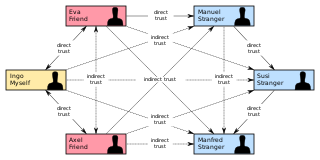
In cryptography, a web of trust is a concept used in PGP, GnuPG, and other OpenPGP-compatible systems to establish the authenticity of the binding between a public key and its owner. Its decentralized trust model is an alternative to the centralized trust model of a public key infrastructure (PKI), which relies exclusively on a certificate authority. As with computer networks, there are many independent webs of trust, and any user can be a part of, and a link between, multiple webs.
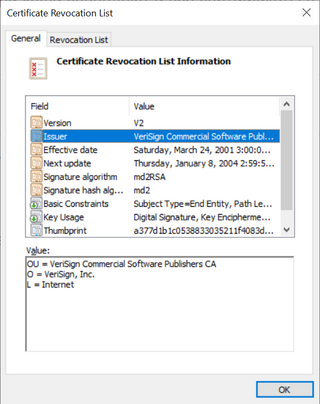
In cryptography, a certificate revocation list (CRL) is "a list of digital certificates that have been revoked by the issuing certificate authority (CA) before their scheduled expiration date and should no longer be trusted". CRLs are no longer required by the CA/Browser forum, as alternate certificate revocation technologies are increasingly used instead. Nevertheless, CRLs are still widely used by the CAs.
In cryptography, a certificate authority or certification authority (CA) is an entity that stores, signs, and issues digital certificates. A digital certificate certifies the ownership of a public key by the named subject of the certificate. This allows others to rely upon signatures or on assertions made about the private key that corresponds to the certified public key. A CA acts as a trusted third party—trusted both by the subject (owner) of the certificate and by the party relying upon the certificate. The format of these certificates is specified by the X.509 or EMV standard.
The Domain Name System Security Extensions (DNSSEC) are a suite of extension specifications by the Internet Engineering Task Force (IETF) for securing data exchanged in the Domain Name System (DNS) in Internet Protocol (IP) networks. The protocol provides cryptographic authentication of data, authenticated denial of existence, and data integrity, but not availability or confidentiality.
In cryptography and computer security, self-signed certificates are public key certificates that are not issued by a certificate authority (CA). These self-signed certificates are easy to make and do not cost money. However, they do not provide any trust value.
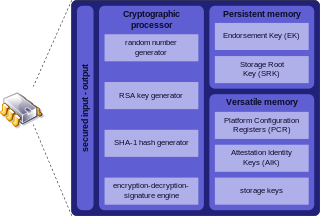
Trusted Platform Module (TPM) is an international standard for a secure cryptoprocessor, a dedicated microcontroller designed to secure hardware through integrated cryptographic keys. The term can also refer to a chip conforming to the standard ISO/IEC 11889.

A hardware security module (HSM) is a physical computing device that safeguards and manages secrets, performs encryption and decryption functions for digital signatures, strong authentication and other cryptographic functions. These modules traditionally come in the form of a plug-in card or an external device that attaches directly to a computer or network server. A hardware security module contains one or more secure cryptoprocessor chips.
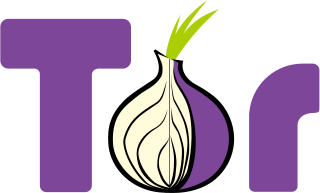
.onion is a special-use top level domain name designating an anonymous onion service, which was formerly known as a "hidden service", reachable via the Tor network. Such addresses are not actual DNS names, and the .onion TLD is not in the Internet DNS root, but with the appropriate proxy software installed, Internet programs such as web browsers can access sites with .onion addresses by sending the request through the Tor network.
Code signing is the process of digitally signing executables and scripts to confirm the software author and guarantee that the code has not been altered or corrupted since it was signed. The process employs the use of a cryptographic hash to validate authenticity and integrity. Code signing was invented in 1995 by Michael Doyle, as part of the Eolas WebWish browser plug-in, which enabled the use of public-key cryptography to sign downloadable Web app program code using a secret key, so the plug-in code interpreter could then use the corresponding public key to authenticate the code before allowing it access to the code interpreter’s APIs.
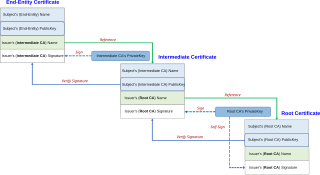
In computer security, a chain of trust is established by validating each component of hardware and software from the end entity up to the root certificate. It is intended to ensure that only trusted software and hardware can be used while still retaining flexibility.
In public-key cryptography, a public key fingerprint is a short sequence of bytes used to identify a longer public key. Fingerprints are created by applying a cryptographic hash function to a public key. Since fingerprints are shorter than the keys they refer to, they can be used to simplify certain key management tasks. In Microsoft software, "thumbprint" is used instead of "fingerprint."

DigiCert, Inc. is a digital security company headquartered in Lehi, Utah. As a certificate authority (CA) and trusted third party, DigiCert provides public key infrastructure (PKI) and validation required for issuing digital certificates or TLS/SSL certificates.
The Certification Authority Browser Forum, also known as the CA/Browser Forum, is a voluntary consortium of certification authorities, vendors of Internet browser and secure email software, operating systems, and other PKI-enabled applications that promulgates industry guidelines governing the issuance and management of X.509 v.3 digital certificates that chain to a trust anchor embedded in such applications. Its guidelines cover certificates used for the SSL/TLS protocol and code signing, as well as system and network security of certificate authorities.
StartCom was a certificate authority founded in Eilat, Israel, and later based in Beijing, China, that had three main activities: StartCom Enterprise Linux, StartSSL and MediaHost. StartCom set up branch offices in China, Hong Kong, the United Kingdom and Spain. Due to multiple faults on the company's end, all StartCom certificates were removed from Mozilla Firefox in October 2016 and Google Chrome in March 2017, including certificates previously issued, with similar removals from other browsers expected to follow.
References
- ↑ Wallace, Carl; Ashmore, Sam; Housley, Russ (June 2010). "Trust Anchor Format". RFC 5914 . IETF . Retrieved 2022-03-30.